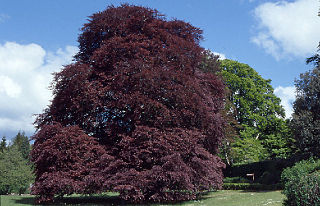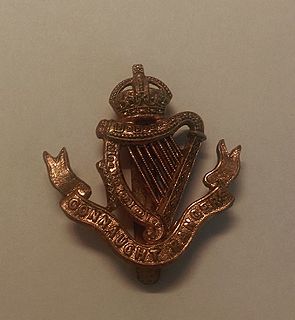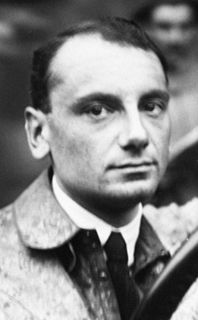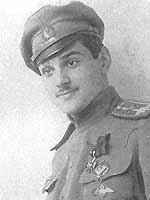| Personal information | |||||||||||||||||||||||||||
|---|---|---|---|---|---|---|---|---|---|---|---|---|---|---|---|---|---|---|---|---|---|---|---|---|---|---|---|
| Born | 21 May 1881 3 St. George's Place, London, England | ||||||||||||||||||||||||||
| Died | 23 January 1918 (aged 36) Monastiero, Padua, Italy | ||||||||||||||||||||||||||
| Batting | Right-hand batsman | ||||||||||||||||||||||||||
| Bowling | Leg-break and googly | ||||||||||||||||||||||||||
| Relations | William Henry Gregory (father) Augusta, Lady Gregory (mother) | ||||||||||||||||||||||||||
| Career statistics | |||||||||||||||||||||||||||
| |||||||||||||||||||||||||||
Source: CricketAchieve, 24 November 2015 | |||||||||||||||||||||||||||
William Robert Gregory MC (20 May 1881 in County Galway, Ireland – 23 January 1918 near Grossa, Padua, Italy [1] ) was an Irish cricketer, artist and flying ace in WWI.

The Military Cross (MC) is the third-level military decoration awarded to officers and other ranks of the British Armed Forces, and formerly awarded to officers of other Commonwealth countries.

County Galway is a county in Ireland. It is located in the West of Ireland, part of the province of Connacht.

Ireland is an island in the North Atlantic. It is separated from Great Britain to its east by the North Channel, the Irish Sea, and St George's Channel. Ireland is the second-largest island of the British Isles, the third-largest in Europe, and the twentieth-largest on Earth.
The only child of William Henry Gregory and Lady Gregory, an associate of W. B. Yeats, Robert was born in County Galway in Ireland in May 1881. He studied at Harrow, Oxford University and the Slade School of Art [2] he excelled at bowls, boxing, horse riding [2] and cricket. He was good enough at cricket to play once for the Ireland cricket team, [3] taking 8/80 with his leg spin bowling in a first-class match against Scotland in 1912. He didn't score a run. [4] His bowling performance in that match remains the tenth best in all matches for Ireland [5] and the fourth best in first-class cricket for Ireland. [6] His bowling average of 10.22 is the second best for Ireland in first-class cricket. [7]

Sir William Henry Gregory PC (Ire) KCMG was an Anglo-Irish writer and politician, who is now less remembered than his wife Augusta, Lady Gregory, the playwright, co-founder and Director of Dublin's Abbey Theatre, literary hostess and folklorist.

Isabella Augusta, Lady Gregory was an Irish dramatist, folklorist and theatre manager. With William Butler Yeats and Edward Martyn, she co-founded the Irish Literary Theatre and the Abbey Theatre, and wrote numerous short works for both companies. Lady Gregory produced a number of books of retellings of stories taken from Irish mythology. Born into a class that identified closely with British rule, she turned against it. Her conversion to cultural nationalism, as evidenced by her writings, was emblematic of many of the political struggles to occur in Ireland during her lifetime.

William Butler Yeats was an Irish poet and one of the foremost figures of 20th-century literature. A pillar of the Irish literary establishment, he helped to found the Abbey Theatre, and in his later years served as a Senator of the Irish Free State for two terms. He was a driving force behind the Irish Literary Revival along with Lady Gregory, Edward Martyn and others.
Growing up in the couple's houses in Ireland and England (Coole Park and London), he was educated at the Harrow School and the University of Oxford [8]

Coole Park is a nature reserve of approximately 1,000 acres (4 km2) located a few miles west of Gort, County Galway, Ireland. It is managed by the Irish National Parks & Wildlife Service, part of the Department of Arts, Heritage and the Gaeltacht. The park is in a low–lying karstic limestone area characterised by seasonal lakes, known as turloughs, which are almost unique to Ireland. It has extensive woodlands. There are 6 kilometres of signposted nature trails plus a formal late 18th century walled garden.

Harrow School is an independent boarding school for boys in Harrow, London, England. The School was founded in 1572 by John Lyon under a Royal Charter of Elizabeth I, and is one of the original seven public schools that were regulated by the Public Schools Act 1868. Harrow charges up to £12,850 per term, with three terms per academic year (2017/18). Harrow is the fourth most expensive boarding school in the Headmasters' and Headmistresses' Conference.

The University of Oxford is a collegiate research university in Oxford, England. There is evidence of teaching as far back as 1096, making it the oldest university in the English-speaking world and the world's second-oldest university in continuous operation. It grew rapidly from 1167 when Henry II banned English students from attending the University of Paris. After disputes between students and Oxford townsfolk in 1209, some academics fled north-east to Cambridge where they established what became the University of Cambridge. The two 'ancient universities' are frequently jointly referred to as 'Oxbridge'. The history and influence of the University of Oxford has made it one of the most prestigious universities in the world.
An accomplished artist, he studied in London at the Slade School of Fine Art [9] , eventually marrying another Slade student, Margaret Parry; he worked in Paris at the design studio of Jacques Émile Blanche, and had his own exhibition of paintings in Chelsea in 1914. He was also an illustrator for books and stage. [10]

The UCL Slade School of Fine Art is the art school of University College London (UCL) and is based in London, United Kingdom. It is world-renowned and is consistently ranked as the UK's top art and design educational institution. The school is organised as a department of UCL's Faculty of Arts and Humanities.

Chelsea is an affluent area of West London, bounded to the south by the River Thames. Its frontage runs from Chelsea Bridge along the Chelsea Embankment, Cheyne Walk, Lots Road and Chelsea Harbour. Its eastern boundary was once defined by the River Westbourne, which is now in a pipe above Sloane Square Underground station. The modern eastern boundary is Chelsea Bridge Road and the lower half of Sloane Street, including Sloane Square. To the north and northwest, the area fades into Knightsbridge and Brompton, but it is considered that the area north of King's Road as far northwest as Fulham Road is part of Chelsea.
The following year, he joined the war effort, although he was now 34, and had three children. He briefly became a member of the 4th Connaught Rangers, but quickly transferred in 1916 to the Royal Flying Corps. A fighter pilot, he eventually was credited with eight victories [11] . His colleagues Mick Mannock and George McElroy, with many more victories, became much better known, but he was the first of the Irish pilots to achieve ace status in 40 Squadron RFC. France made him a Chevalier of the Legion d'Honneur in 1917, and he was awarded a Military Cross for "conspicuous gallantry and devotion to duty." [2]

The Connaught Rangers were an Irish line infantry regiment of the British Army formed by the amalgamation of the 88th Regiment of Foot and the 94th Regiment of Foot in July 1881. Between the time of its formation and Irish independence, it was one of eight Irish regiments raised largely in Ireland. Its home depot was in Galway. It was disbanded following the establishment of the independent Irish Free State in 1922, along with the other five regiments that had their traditional recruiting grounds in the counties of the new state.

The Royal Flying Corps (RFC) was the air arm of the British Army before and during the First World War, until it merged with the Royal Naval Air Service on 1 April 1918 to form the Royal Air Force. During the early part of the war, the RFC supported the British Army by artillery co-operation and photographic reconnaissance. This work gradually led RFC pilots into aerial battles with German pilots and later in the war included the strafing of enemy infantry and emplacements, the bombing of German military airfields and later the strategic bombing of German industrial and transport facilities.

Edward Corringham "Mick" Mannock was a British flying ace in the Royal Flying Corps and Royal Air Force during the First World War. Mannock was a pioneer of fighter aircraft tactics in aerial warfare. At his death he had amassed 61 aerial victories, the fifth highest scoring pilot of the war; the RAF officially recognises 73 aerial victories
He flew the Royal Aircraft Factory RE-8, the French Nieuport, and, at the time of his death, the Sopwith Camel.

The Sopwith Camel was a British First World War single-seat biplane fighter aircraft introduced on the Western Front in 1917. It was developed by the Sopwith Aviation Company as a successor to the earlier Sopwith Pup and became one of the best known fighter aircraft of the war.
He was killed in Italy at the age of 36. It has been commonly stated that he was the victim of "friendly fire", when an Italian pilot mistakenly shot him down. [2] . However, his death is also referred to in other sources as a flying accident [12] . Further, in 2017, Geoffrey O'Byrne White, a director of the Irish Aviation Authority, great-grandnephew of Lady Gregory, and former pilot in the Irish Air Corps, said he believed Gregory had become incapacitated at high altitude, attributing this to an inoculation for influenza. [13]
Robert's death had a lasting effect on W. B. Yeats, and he became the subject of four poems by him, although Lady Gregory is reported not to have agreed with all of their content [14] . They are: In Memory of Major Robert Gregory, An Irish Airman Foresees His Death, Shepherd and Goatherd, and Reprisals. [2] . Lines from "An Irish Airman Foresees His Death" were recited by one of the crew of a Boeing B-17 Flying Fortress in the 1990 film Memphis Belle (film) [15] .





